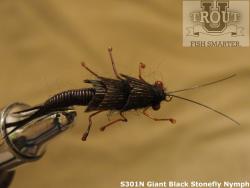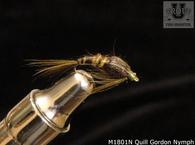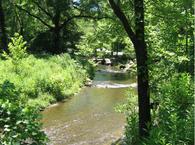
In this class, you will learn about and how to fly fish the Czech Nymph Method, including the history, rigging, flies, and strategy behind Czech Nymphing.
The Czech nymph method of fly fishing is rapidly gaining popularity due to a couple of advantages. First, a fly line or strike indicator carries the possibility of spooking the trout because the trout may hear the line or indicator hitting the water or they may see the line or indicator. Therefore, stealth is an advantage. The second advantage has to do with the speed of the water and how the fly line would react to the water. With a fly line, it might be necessary to mend the line due to the current speed at the surface being different and faster than the current at the bottom of the water column. The monofilament leader without the presence of the fly line will enable the fly to get to the bottom faster and with a more realistic speed. Also, the nymph will follow or hug the bottom humps and drop offs more closely.
Czech nymph fishing, despite it's name, can be traced back to the Polish fly fishing tournament anglers. The Polish team that introduced the technique to the rest of the world handily won a 1984 international fly fishing tournament with a new technique for fly fishing nymphs. The Czech took the technique, and made it their own, developing it further. Two years later, the Czech won the tournament using the “Polish nymph method” as it was known at the time.
The Czech nymphing method of fly fishing, is similar in many respects to its more American cousin, the high sticking method of nymph fishing. Similarly, Czech nymph can produce good results when used in the right type of water. This technique, which was originally used for bottom feeding grayling, is based on dragging nymphs along the bottom of the stream. Furthermore, every possible hiding place for the trout is targeted. This technique cannot be used successfully in slow, smooth water. One of the most difficult aspects to Czech nymphing is that the fly fisherman must position himself in very close proximity to the trout without alerting them of his presence. The success of this technique depends mostly on your ability to find the trout's hiding spots and to read the water properly.
Czech nymphing is a great technique for fly fishing fast pocket water, where trout may be hiding under the broken water surface and in the cracks and openings in the rocks. You can come much closer to the trout without scaring them in these turbulent water conditions.
As far as Czech nymphing fly gear is concerned, the Czech use a relatively long fly rod, typically around 10 feet long, with a lightweight rod, reel, and line combination. You will want to keep the equipment as light as possible since you will be holding the rod up and away from the body and any additional weight will be a burden after time. The 10 ft. length will allow you to reach water further away, while the light weight will allow you to sense a take. You will need a rod with a slightly stiff tip to sense the takes, but not so stiff that it won't give a little when a trout surges during the fight. A ten foot, 4-5 weight fly rod is the general recommendation for the gear. The casting characteristics are not that significant, since you will not be making long casts.
The Czech use very bright leaders, so that they can see the line's movement easily to help detect strikes. Also, the Czech use a different type of leader than we're used to using. To help the leader sink faster, they use a fluorocarbon leader, rather than nylon, though this is a matter of preference. Furthermore, since casting long distances is not preeminent in this type of fishing, they do not use tapered leaders. The length of the leader from the end of the fly line to the upper nymph should be approximately 1.5-2X the depth of the water you are fishing with a maximum of 10 feet.
Czech fishermen fish three nymphs at a time, with the heaviest fly placed in the middle. If it's not legal to fish three nymphs at a time where you fish, you can fish a tandem rig with the heavier fly further up the leader and the lighter fly at the end of the line. Additionally, typically, the only weight used is in the nymph itself, which is tied with lead in it. Occasionally, they will use a bead head nymph for additional weight.
Next, let's discuss an American version of the Czech method rigging. You will probably be using a 2 fly rig, and you should place the heavier nymph closer to the rod. Tie the upper, eavier fly on an 8 inch dropper, attached to the leader 18 inches above the lighter fly at the far end of the leader. The length of the leader from the end of the line to the upper fly's dropper should be about 1.5 times the depth you plan to fish it. The total length of the leader on most streams should not exceed 10 feet. Attach the dropper to the leader with a Uni-knot. The dropper can be of the same pound test as the leader, or perhaps a size smaller so you won't lose the hole rig if you get hung up.
You can use heavily weighted nymphs without additional weight, or you can use unweighted flies with enough split shot to get the flies to the bottom in the swift water you will be fishing in. We, of course, recommend Perfect Fly brand flies, which are unweighted, with additional split shot. The reason is that Perfect Fly brand flies are specific imitations of actual insects, not generic flies. In the event that you tie your own flies, it is uggested that you use kneeled hooks. Kneeled hooks will keep the hook away from the bottom allowing for far less hangups. The normal fly hook will snag on rock and debris while the keeled hook will be more effective.
For example, using a Perfect Fly Giant Black Stonefly for the upper fly works great, because these flies are heavy and often doesn't require additional weight. Additionally, the actual insects spend several years in the stream, so there are always some present in streams where they live – not just around the time of the hatch.
Alternatively, the Perfect Fly Golden Stonefly (size 12) works well. Similarly, these insects live up to three years, and consequently there are always some of these around. These flies are not as heavy as the Giant Black Stoneflies, so you may need a split shot about 8 inches above the top fly. The size of the split shot depends on the water speed and depth.
Another good option for the upper fly is the Perfect Fly Little Yellow Stonefly, though these flies can only be used effectively seasonally. Again, you will need to add split shot above it when using this pattern.
For the lower fly, use a Perfect Fly nymph imitating whatever is hatching or about to hatch on the stream you're fishing. This fly should be much lighter than the upper fly.
To fish the rig, you will need a small amount of fly line extending past the end of your fly rod's tip, roughly equal to between 1/2X – 1X the overall length of your leader. The fly line however, should not touch the water and usually will not be far enough out so that the trout can see it.
While standing facing one of the banks, looking perpendicular to the current flow, cast upstream 45 degrees across the current. Your fly rod should be parallel with the ground as you conclude your cast. You can effectively extend your cast by stretching your arm out as far as you can reach while you cast. Your arm should also be parallel to the ground, similar to your fly rod, for the entire drift of the flies.
Once your rig has progressed downstream to a 45 degree position, cast again to a new drift. You should make several casts (up to 10) before you change your position, to ensure you fish every spot a trout may be. Detecting a strike can take some practice, just watch the line where it meets the water and watch for movement. After some practice, you will come to recognize the difference between the bump of rocks and the strike of a trout.
However, some anglers will prefer to use a strike indicator. A tiny fluorescent strike indicator may be added to the end of the fly line. The key to the strike indicator is to use as small a one as you can get away with. It is important to maintain the rod tip's location slightly leading the strike indicator throughout the drift. You will simply swing your fly rod slightly in front of the strike indicator.You should keep the slack out of your fly line above the strike indicator, so that you can respond to a strike.
Buy some Perfect Fly brand Giant Black, Golden, and Little Yellow Stoneflies for use with your Czech Nymph rig and purchase some split shot and strike indicators.
By far the best video for Czech Nymphing is a youtube "How to Fly Fish: Czech Nymphing Tutorial" by New Zealand Flyfishing Company.
Practice your casting technique until you are proficient. Develop an understanding of what the flies' hanging on the bottom feels like. Make sure your line has no slack in it throughout the extent of your drifts. Make several leaders, organizing them by length/depth of water.





